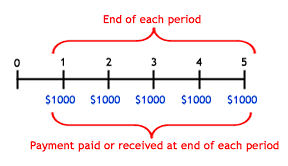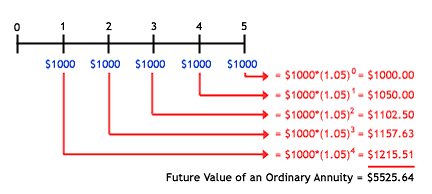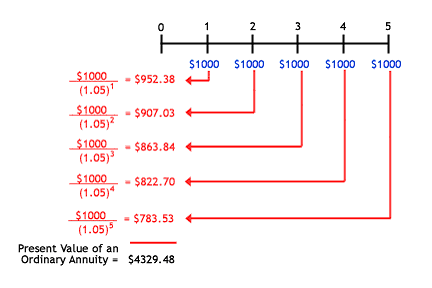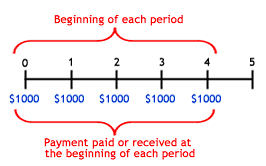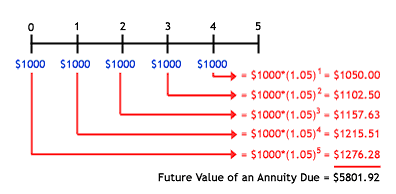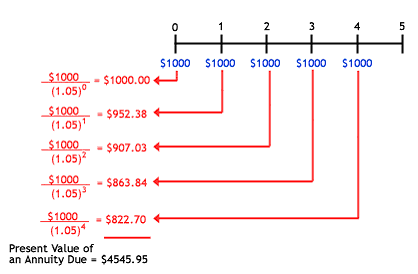At some point in your life you may have had to make a series of fixed
payments over a period of time - such as rent or car payments - or have
received a series of payments over a period of time, such as bond
coupons. These are called
annuities.
If you understand the time value of money and have an understanding of
future and present value you're ready to learn about annuities and how
their present and future values are calculated. (To read more on this
subject, see
Understanding The Time Value Of Money and
Continuously Compound Interest.)
What Are Annuities?Annuities
are essentially series of fixed payments required from you or paid to
you at a specified frequency over the course of a fixed period of time.
The most common payment frequencies are yearly (once a year),
semi-annually (twice a year), quarterly (four times a year) and monthly
(once a month). There are two basic types of annuities: ordinary
annuities and annuities due.
- Ordinary Annuity:
Payments are required at the end of each period. For example, straight
bonds usually pay coupon payments at the end of every six months until
the bond's maturity date.
- Annuity Due:
Payments are required at the beginning of each period. Rent is an
example of annuity due. You are usually required to pay rent when you
first move in at the beginning of the month, and then on the first of
each month thereafter.
Since the present and future value calculations for ordinary annuities
and annuities due are slightly different, we will first discuss the
present and future value calculation for ordinary annuities.
Calculating the Future Value of an Ordinary AnnuityIf you
know how much you can invest per period for a certain time period, the
future value of an ordinary annuity formula is useful for finding out
how much you would have in the future by investing at your given
interest rate. If you are making payments on a loan, the future value is
useful for determining the total cost of the loan.
Let's now run through Example 1. Consider the following annuity cash flow schedule:
In order to calculate the future value of the
annuity, we have to calculate the future value of each cash flow. Let's
assume that you are receiving $1,000 every year for the next five years,
and you invested each payment at 5%. The following diagram shows how
much you would have at the end of the five-year period:
Since we have to add the future value of each
payment, you may have noticed that, if you have an ordinary annuity with
many cash flows, it would take a long time to calculate all the future
values and then add them together. Fortunately, mathematics provides a
formula that serves as a short cut for finding the accumulated value of
all cash flows received from an ordinary annuity:

C = Cash flow per period
i = interest rate
n = number of payments |
If we were to use the above formula for Example 1 above, this is the result:

= $1000*[5.53]
= $5525.63 |
Note that the one cent difference between
$5,525.64 and $5,525.63 is due to a rounding error in the first
calculation. Each of the values of the first calculation must be rounded
to the nearest penny - the more you have to round numbers in a
calculation the more likely rounding errors will occur. So, the above
formula not only provides a short-cut to finding FV of an ordinary
annuity but also gives a more accurate result. (Now that you know how to
do these on your own, check out our
Future Value of an Annuity Calculator for the easy method.)
Calculating the Present Value of an Ordinary AnnuityIf
you would like to determine today's value of a series of future
payments, you need to use the formula that calculates the present value
of an ordinary annuity. This is the formula you would use as part of a
bond pricing calculation. The PV of ordinary annuity calculates the
present value of the coupon payments that you will receive in the
future.
For Example 2, we'll use the same annuity cash flow
schedule as we did in Example 1. To obtain the total discounted value,
we need to take the present value of each future payment and, as we did
in Example 1, add the cash flows together.
Again, calculating and adding all these values
will take a considerable amount of time, especially if we expect many
future payments. As such, there is a mathematical shortcut we can use
for PV of ordinary annuity.

C = Cash flow per period
i = interest rate
n = number of payments |
The formula provides us with the PV in a few
easy steps. Here is the calculation of the annuity represented in the
diagram for Example 2:

= $1000*[4.33]
= $4329.48 |
Not that you'd want to use it now that you know the long way to get
present value of an annuity, but just in case, you can check out our
Present Value of an Annuity Calculator.
Calculating the Future Value of an Annuity DueWhen you are receiving or paying cash flows for an annuity due, your cash flow schedule would appear as follows:
Since each payment in the series is made one
period sooner, we need to discount the formula one period back. A slight
modification to the FV-of-an-ordinary-annuity formula accounts for
payments occurring at the beginning of each period. In Example 3, let's
illustrate why this modification is needed when each $1,000 payment is
made at the beginning of the period rather than the end (interest rate
is still 5%):
Notice that when payments are made at the
beginning of the period, each amount is held for longer at the end of
the period. For example, if the $1,000 was invested on January 1st
rather than December 31st of each year, the last payment before we value
our investment at the end of five years (on December 31st) would have
been made a year prior (January 1st) rather than the same day on which
it is valued. The future value of annuity formula would then read:
Therefore,

= $1000*5.53*1.05
= $5801.91 |
Check out our
Future Value Annuity Due Calculator to save some time.
Calculating the Present Value of an Annuity DueFor
the present value of an annuity due formula, we need to discount the
formula one period forward as the payments are held for a lesser amount
of time. When calculating the present value, we assume that the first
payment was made today.
We could use this formula for
calculating the present value of your future rent payments as specified
in a lease you sign with your landlord. Let's say for Example 4 that you
make your first rent payment at the beginning of the month and are
evaluating the present value of your five-month lease on that same day.
Your present value calculation would work as follows:
Of course, we can use a formula shortcut to calculate the present value of an annuity due:
Therefore,

= $1000*4.33*1.05
= $4545.95 |
Recall that the present value of an ordinary
annuity returned a value of $4,329.48. The present value of an ordinary
annuity is less than that of an annuity due because the further back we
discount a future payment, the lower its present value: each payment or
cash flow in ordinary annuity occurs one period further into future.
Check out our
Present Value Annuity Due Calculator.
ConclusionNow
you can see how annuity affects how you calculate the present and
future value of any amount of money. Remember that the payment
frequencies, or number of payments, and the time at which these payments
are made (whether at the beginning or end of each payment period) are
all variables you need to account for in your calculations.



%201.gif)




